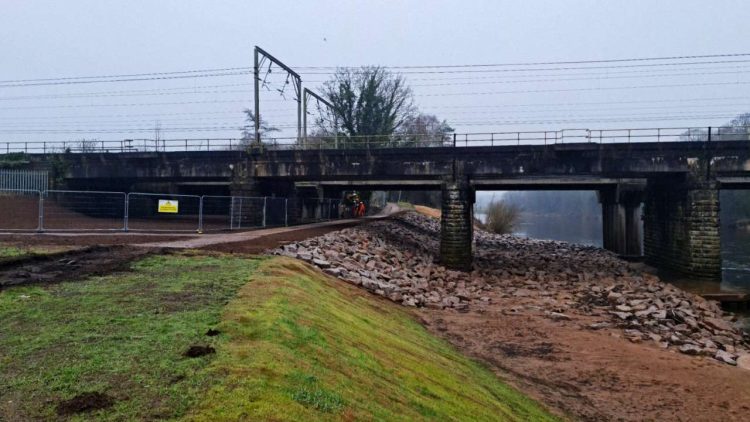Train services on two major routes in Cumbria are now running faster and more reliably after the completion of work to protect three viaducts from the effects of river erosion.
The underwater foundations of the following viaducts were being gradually washed away by strong currents in the River Eden:
- a 1940s-built concrete structure that carries goods lines on the West Coast main line in Carlisle;
- an adjacent viaduct dating back to the Victorian-era that passenger trains use;
- Long Meg viaduct on the Settle to Carlisle line.

Since the summer of 2021, Network Rail has invested £5.1m to protect the viaducts and has used detailed hydrographic surveys of the riverbed to plan essential maintenance. These surveys showed the extent to which water has ‘scoured' away the viaduct supports over time.
Recently, the rate of scouring has been accelerating alarmingly because of heavier rainfall as a result of climate change. As a precaution trains, a reduced speed limit of 20mph was imposed on trains crossing the structures.
The hydrographic survey used a lightweight remote-controlled boat to send GPS or echo sounders between it and the riverbed to measure the distance. These were recorded to build a three-dimensional underwater map of the terrain which was then converted into a computer model to enable calculations to be made of exactly how much material was needed to secure the viaducts' underwater foundations.
These procedures for riverbed surveys have now been adopted as standard for investigating other cases of significant river scour on railway structures.
Because much of the work involved working in the river, Network Rail worked closely with the Environment Agency and Natural England to ensure the work had minimal impact on wildlife. Among the measures was the development of a special mix of environmentally safe ‘non leach' concrete that professional divers pumped into gaps in the structures that were underwater.
WATCH: Work taking place on the River Eden viaducts
Work took place in two stages, with temporary repairs carried out in the summer of 2021 and final repairs last summer and autumn. At each viaduct, huge boulders known as ‘rock armour' were placed in the water to divert the river around the viaduct supports.
During the most recent phase of work last year, 1,850m3 or 4,000 tonnes of special setting concrete was poured, 5,000 tonnes of boulders or ‘rock armour' were positioned in the river, and 16,800 hours of work took place.
Long Meg viaduct bathymetric survey after work in Nov 2022
In recent weeks, engineers have monitored the water flows at each site, and found that the upgrades are working exactly as intended. As a result, all speed restrictions have been removed and the full line speed of up to 100mph reinstated, meaning faster journeys for passengers and freight operators.
Rob Stephens, Network Rail principal route engineer, said: “Now the winter rains are once again swelling the River Eden our vital work to protect the three railway viaducts is being put to its first big test, and it's great to see our improvements protecting rail passengers and freight trains.
“These projects have been challenging and have blended technological and engineering innovations alongside traditional techniques. Using new technology will be crucial as we make the railway more resilient from severe weather and our changing climate in future.”
Information on how Network Rail maintains its viaducts and bridges is available online at https://www.networkrail.co.uk/running-the-railway/looking-after-the-railway/bridges-tunnels-and-viaducts/